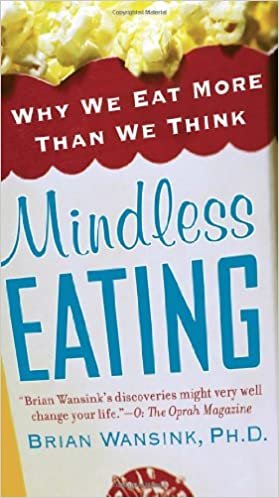“The best diet is the one you don’t know you’re on,” says Brian Wansink, Ph.D., author of Mindless Eating: Why We Eat More Than We Think. That is what I call ‘music to my ears’! I thought I would never read this in a book which explores such subjects as eating behavior, dieting and weight loss. Wansink explains: “Most diets are deprivation diets.
We deprive ourselves or deny ourselves of something – carbohydrates, fat, red meat, snacks, pizza, breakfast, chocolate, and so forth. Unfortunately, deprivation diets don’t work for three reasons:
1) Our body fights against them; 2) our brain fights against them; and 3) our day-to-day environment fights against them. Millions of years of evolution have made out body too smart to fall for our little: “I’m only eating salad’ trick.”
According to his research, we are faced with “more than 200 food-related decisions each day.” The solution? Rather than depriving ourselves of our favorite foods, making “invisible” changes to our eating habits goes a long way.
“If we don’t realize we’re eating a little less than we need, we don’t feel deprived. If we don’t feel deprived, we’re less likely to backslide and find ourselves overeating to compensate for everything we’ve forgone,” he says.
Simple? Yes. Effective? You bet! Mindless Eating is certainly not a diet book, which is why I am so excited about it.
In it, you will not find meal plans, exercise routines, convoluted formulas, food lists or anything that you typically find in a diet book.
While the book is based on scientific studies – which were designed and conducted under Dr. Wansink’s supervision at the Cornell University’s Food and Brand Lab – it is not a boring read.
In fact, I cannot recall ever reading such a riveting book on the subject of dieting, food psychology and weight loss. Trust me, it is that good.
So at this point, you might be asking yourself. “Wait a minute, if it is not a diet book, how can it help me lose weight and make better food choices?”
According to Mindless Eating, “If we eat way too little, we know it. If we eat way too much, we know it. But there is a calorie range – a mindless margin – where we feel fine and are unaware of small differences.
That is, the difference between 1,900 calories and 2,000 calories is one we cannot detect, nor can we detect the difference between 2,000 and 2,100 calories.”
What is the secret to the “mindless margin”? Brian Wansink says, “It’s easy to rearrange your kitchen and change a few eating habits so you don’t have to think about eating less or differently.”
He recommends gradual changes; reducing your caloric intake by 100 or 200 calories a day will not make you feel deprived and craving for your favorite foods.
“Cutting out our favorite foods is a bad idea. Cutting down on how much of them we eat is mindlessly do-able. Many fad diets focus more on the types of foods we can eat rather than how much we should eat.
But the problem isn’t that we order beef instead of a low-fat chicken breast. The problem is that the beef is often twice the size.
A low-fat chicken breast that we resent having to eat may be no better for out long-term diet than a tastier but slightly smaller piece of beef,” says Wansink.
The book provides specific suggestions on how to make “small adjustments” to your “eating environment – ways you can reengineer it to avoid being trapped by an extra 100 calories here and there.”
These small changes should not only help you lose weight, but also keep it off for good.

